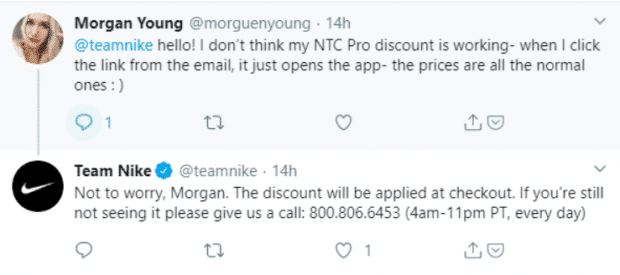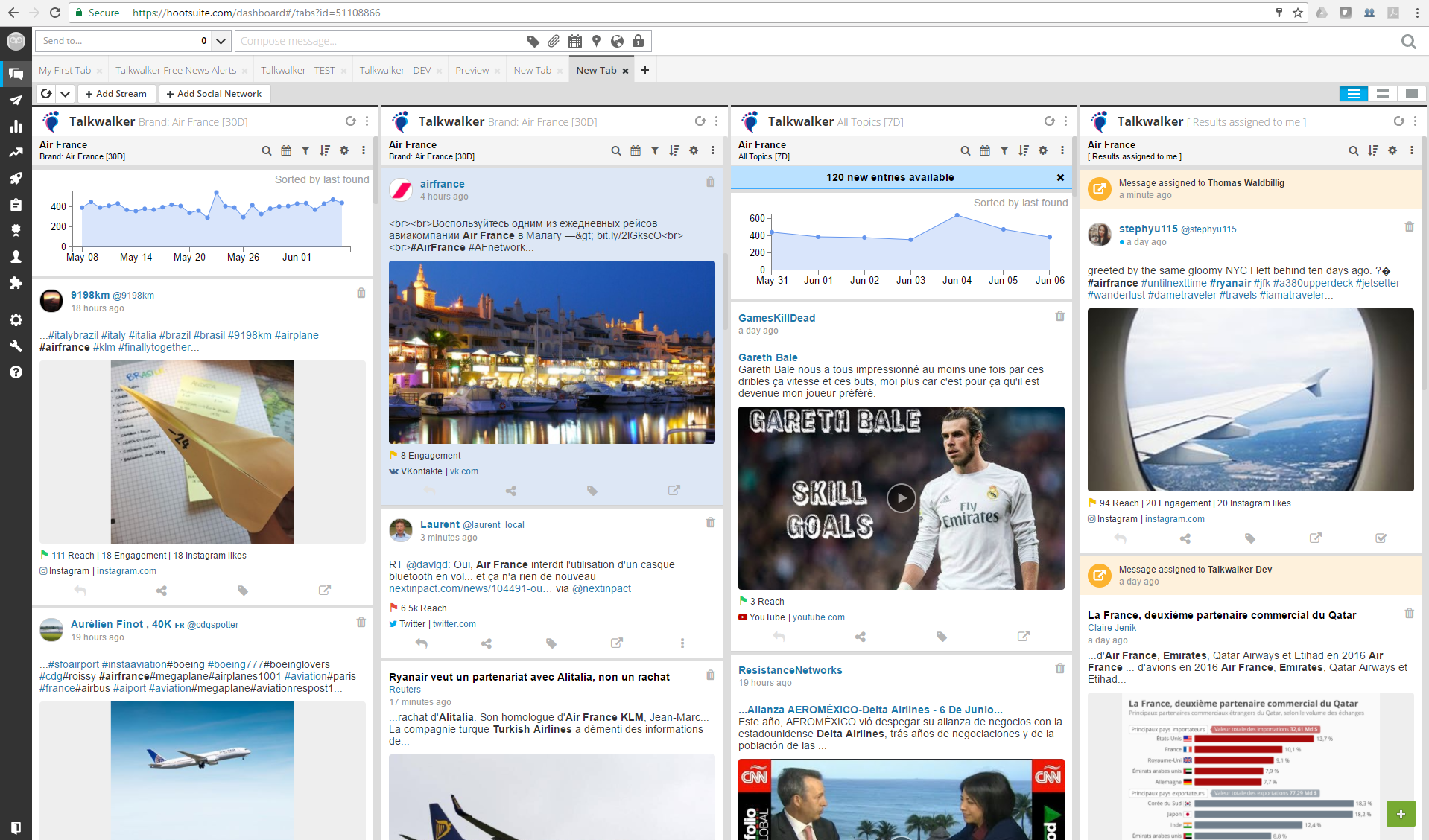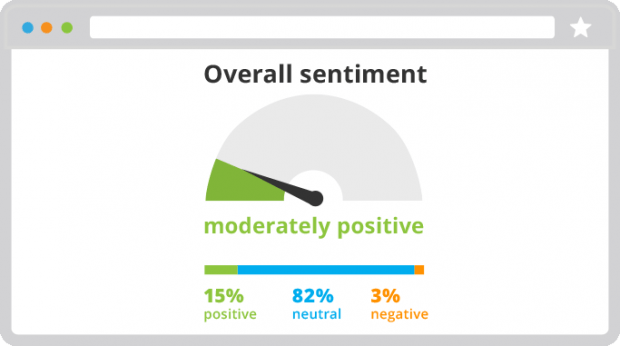Social listening gives brands an opportunity to track, analyze, and respond to conversations about them on social media. It’s a crucial component of audience research.
Imagine you own a coffee shop. One day while you’re making a latte behind the counter, you overhear two customers in line talk about your food selection.
“I love the pastries here,” one says. “Especially the croissants.”
“Yeah, the croissants are great,” the other one replies. “But I’m not too crazy about cookies. Way too dry.”
You begin to wonder. Hmm. Does everyone feel this way about the cookies?
So you start to ask around. You hear other opinions about your coffee shop. You start to listen. Based on what you hear you start to make changes that people like.
And it works. Your customers are lining out the door to get a hold of your new cookies. That’s because you just employed a tried-and-true method for brands to engage with their customers and give them what they love:
Social listening
If you’re not using social listening, you’re leaving a lot of great insights on the table.
Here’s how you can get started—and the tools to make it simple.
Table of Contents
What is social listening
Why social listening matters
How to get set up for social listening
Social listening tips
Social listening tools
Social listening definition
Social listening is when you track your social media platforms for mentions and conversations related to your brand. Then you analyze them for insights to discover opportunities to act.
It’s a two step process:
- Step 1: Monitor social media channels for mentions of your brand, competitors, products, and keywords related to your business.
- Step 2: Analyze the information for ways to put what you learn into action. That can be something as small as responding to a happy customer, or something as big as shifting your entire brand positioning.
At first glance, social listening might seem like social media monitoring—but the two concepts actually differ in important ways.
Social media monitoring is simply taking a look at metrics such as:
- Brand mentions
- Relevant hashtags
- Competitor mentions
- Industry trends
…and collecting data about those metrics. Social media monitoring is great for things like monitoring ROI or A/B testing campaigns.
When you take action in response to the data you collected, you begin the process of social listening.
Where social media monitoring looks at metrics like engagement rate and number of mentions, social listening looks beyond the numbers to consider the mood behind the data.
This helps you understand how people feel about you and your competitors. It’s not just counting the number of times your brand gets mentioned.
This “online mood” is also called social media sentiment. Keeping tabs on social media sentiment is a key part of social media listening.
Understanding how people feel about your brand helps you keep your marketing and product development efforts on track. It also allows you to respond right away to positive or negative posts.
Why social listening matters
If you don’t use social media listening, you’re leaving a lot of valuable insights on the table.
In fact, you might be missing out on a big piece of insight about your brand that people are actively discussing. You want to know what people are saying about you.
Your customers are telling you what they want from your brand. If you care about them, you need to take a look at the insights you might gain from social listening.
Here are a few ways social listening can help you:
Engage with customers
Social listening gives you opportunities to engage with your customers about your brand.
For example, a customer might have tweeted about how much they loved your product, or they might have reached out to you on social media for a customer service request.
Nike does this very well. In fact, they have an entire Twitter account dedicated to responding to customer support issues.

It’s not always direct replies either. Sometimes they spot a trend and address it right away.

Another great example comes from Coca-Cola. They frequently respond to followers who tweet about their product—and follow up with them in their DMs.
We are loving your Energy! DM us to follow up. ⚡️
— Coca-Cola (@CocaCola) March 3, 2020
This creates goodwill with their followers and boosts engagement. Consider how your brand can do the same.
Manage crises
Engagement is good—but only when it comes with positive social sentiment.
Social listening allows you to track that sentiment in real time. That way you can see what posts are doing well for your brand, and which ones aren’t.
If you’re getting a lot of positive engagement, look for the reasons behind it. Your customers share a ton of useful information about what they like and what they don’t. Those lessons can help guide your strategy across channels.
Social listening also helps you address PR disasters before they get out of hand. If sentiment is down, review the social feedback for lessons that could prevent a similar misstep in the future.
If sentiment is way down, look for the cause and make changes right away, by pulling a problem post, or apologizing for an insensitive Tweet.
One great example of this comes from Nike. In 2019, they found their brand in the center of controversy when Duke basketball player Zion Williamson’s Nike shoe exploded in the middle of a game.
Nike’s stock fell after Duke star Zion Williamson’s shoe exploded on the court during a game. @ChristineRomans reports on the fallout: https://t.co/FWzAQXME86 pic.twitter.com/oLSGZqKAW8
— CNN (@CNN) February 22, 2019
The game was on national television. So when it happened, influencers and celebrities took to twitter to voice their concern for the player—as well as throw some shade on Nike.
Hope young fella is ok! Literally blew thru his ????. ????????
— LeBron James (@KingJames) February 21, 2019
Nike’s social media team wasted no time jumping on the grenade. They took time to respond to tweets from concerned customers, and their PR team released a statement the next day wishing Willamson well and promising to investigate the matter.
They also reached out to Willamson himself and offered him an advertising deal.
Raheem Sterling’s $120 million Air Jordan deal would elevate him above Zion Williamson’s earnings with the iconic shoe brand https://t.co/iTFu670sUs
— Sports Insider (@SportsInsider) August 14, 2019
The goodwill, commitment, and humility in the face of crisis allowed Nike to rise above the situation.
Track competitors
Social listening is more than understanding what people say about you. You also want to know what they say about your competitors. This gives you important insights into where you fit in the marketplace.
You will also learn what your competitors are up to in real-time. Are they launching new products? Developing new marketing campaigns? Taking a beating in the press?
Social listening allows you to find out about these new opportunities and threats as they happen, so you can plan and respond accordingly.
Find pain points
Monitoring conversations around the industry uncovers a TON of insight about what’s working and—more importantly—what’s not working for your customer.
This information is a gold mine for your product and marketing team.
Can you tweak an existing product or add a feature to resolve the problems people are talking about? Maybe what you learn will spur a new product idea.
You’ll also learn about frustrations with your current products. Can you tweak your products to help address the concerns? If you do, be sure to tell people about it with a targeted marketing campaign.
Discover new sales leads
It’s a truth universally acknowledged that customers love it when you solve their problems. It’s also a truth universally acknowledged that customers hate being sold to right away with the white hot passion of a dying star.
Social listening helps you develop relationships with potential customers in your industry who you can nurture into relationships for social selling.
Reach out, make a connection, and share helpful information. This will help establish your brand as the best resource when it comes time to make a purchase decision.
Identify influencers and advocates
Monitoring social conversation about your industry will give you a sense of who the important influencers are. These are important people to connect with. As the term implies, they can have a huge influence on how their followers and fans feel about you—or your competitors.
You will also find people who already love your brand and are saying great things about you on social media. These are natural brand advocates. Reach out to them and look for opportunities to collaborate.
How to get set up for social media listening
Good social listening is all about what you’re listening for. That means choosing the right (read: relevant) keywords for your brand.
The social manager for a family restaurant in Duluth, Minnesota isn’t listening to the same keywords as that hip tattoo shop in Los Angeles, California.
(Who knows though? Maybe that family restaurant is super hip, too.)
The keywords and topics you monitor will likely evolve over time. Using social listening tools, you will learn what kinds of words people tend to use when they talk about your business and your industry. You’ll also start to get a sense of what kinds of insights are most useful for you.
That said, here’s a list of important keywords and topics to monitor right from the start:
- Your brand name and handles
- Your product name(s), including common misspellings
- Your competitors’ brand names, product names, and handles
- Industry buzzwords
- Your slogan and those of your competitors
- Names of key people in your company and your competitors’ companies (your CEO, spokesperson, etc.)
- Campaign names or keywords
- Your branded hashtags and those of your competitors
- Unbranded hashtags related to your industry
5 social listening tips
Below is some of our best advice for social listening. Use it to get the most bang for your buck when you try it out.
1. Listen everywhere
Find out where your audience is talking about you—not just what they say.
That means casting a wide net for your social listening program.
Conversations around your brand on LinkedIn are likely going to be much different than on Instagram. And you might find that people talk about you all the time on Twitter, but not on Facebook.
Knowing where they talk about you is as important as how they talk about you. It will give you a clear strategy on joining the conversation via organic engagement and paid advertising.
2. Learn from your competition
You can always learn something from your competitors.
You can especially learn something from what people say about them.
See what they do right and what people love about them. But most importantly, see where they misstep and get it wrong.
It’s a lot less painful to learn a hard lesson by watching your competitors make mistakes than by making it yourself.
3. Collaborate with other teams
Social listening provides a wide range of information that is useful for your whole company.
Maybe it’s a customer post that needs a response right away. Maybe it’s a great idea for a blog post. Or maybe it’s an idea for a new product or new feature for an existing product.
The customer service, content marketing, and product development teams could all benefit from what you learn when you’re listening on social media. Make sure to communicate those learnings. And seek input from those teams, too. They might have specific questions you could answer by tweaking your social listening setup.
4. Roll with the changes
As you start to collect social information, you’ll develop a sense of the regular conversation and sentiment around your brand.
Once you know how people feel about you on a regular basis, you’ll know when it changes.
Major changes in engagement or sentiment can mean that the overall perception of your brand has changed. You need to understand why so you can adapt your strategy appropriately. That may mean riding a wave of positivity, or correcting a misstep to get back on course.
5. Take action
Remember: If you don’t take action, you’re only engaged in social media monitoring, not social listening.
Social listening is not just about tracking metrics. It’s about gaining insights into what your customers and potential customers want from you, and how you can give them that.
Make sure to analyze patterns and trends over time, rather than just individual comments. These overall insights can have the most powerful effects in guiding your future strategy.
The 10 best social listening tools
Below are our 10 favorite tools for social listening. They’ll help you monitor all of your platforms—with ease.
1. Hootsuite
You can use Hootsuite to set up social media streams that monitor conversations, keywords, mentions, and hashtags. You’ll also be able to respond to conversations or mentions immediately from one dashboard—instead of going to a bunch of different social sites.
Hootsuite also allows you to follow social media influencers influencers, potential customers, and advocates. You can reach out to them to help spread brand awareness and collaborate on campaigns.
2. Hootsuite Insights (powered by Brandwatch)
Hootsuite Insights goes even further and gives you data from 1.3 trillion social posts in real time. Save keywords or Boolean strings to find meaningful trends and patterns you might miss with social monitoring. Filter your searches for specifics like dates, demographics, and geographies.
This way you can attain even deeper insights on your brand’s sentiment all over the world.
Visualize sentiment around your brand in automatically-generated word clouds and meters.
3. Adview

Adview is tailor made for social listeing on Facebook and Instagram ads. This focused specialization allows you to monitor up to three different Facebook Ad Accounts across unlimited pages.
You’ll also be able to take a look at the analytics behind your Instagram and Facebook ads to see which one is getting more engagement.
And since you can access it from Hootsuite, you’ll be able to reply and comment on different ads right from the dashboard.
4. ReviewTrackers

ReviewTrackers allows you to monitor reviews from more than 50 review sites like TripAdvisor and GoogleMaps within 15 minutes of being posted.
When integrated with Hootsuite, you can analyze the reviews in stream while filtering them to manage the ones that matter most to your brand.
Plus, you can share great reviews of your company to all of your social networks with a few clicks of a button.
5. Talkwalker

Talkwalker offers robust social listening features that analyzes blogs, forums, videos, news sites, review sites, and social networks all in one dashboard. They draw from more than 150 million sources for your data.
You’ll be able to monitor conversations around your brand while analyzing the engagement, reach, comments, and sentiment behind them.
6. Synthesio

Synthesio tracks conversations on highly-specific topics in carefully segmented audiences. It allows you to tag mentions by language, location, demographics, sentiment, and influence. Their reports also come with a handy social reputation score!
The app is great for collaboration too. You’ll be able to assign mentions to other team members to have them resolve or analyze them at your discretion. Great for democratizing social media in your company.
7. Reddit Keyword Monitor

If you’re not on Reddit, you’re missing out on a lot of insights.
Reddit sees more than 120 million unique views a month. It’s filled with web forums (subreddits) primed for in-depth discussions, reviews, and the occasional baby elephant gif.
As such, conversations here are vital sources of social intelligence—and this app will help you track it all.
With Reddit Keyword Monitor, you’ll also be able to monitor unlimited keywords across reddit and easily respond and engage to different posts that discuss your brand and keywords.
8. Audiense

Audiense allows you to identify any audience—no matter the size.
The app creates reports that tell you what they’re discussing, what they like, and even how they think and behave.
Its audience manager also helps you find and understand very specific audiences to make sure you have the perfect match for your brand.
9. Brandwatch Consumer Research
Brandwatch monitors the tone and impact of conversations across 95 million data sources including:
- Blogs
- Forums
- Social networks
- News
- Videos
- Reviews
It also allows you to set up email alerts to let you know when conversations are happening—so you don’t miss out on a single one.
10. Mentionlytics
Track mentions, keywords, and sentiment across multiple languages. Also, you can easily find influencers across social networks and other online sources.
Their monitoring algorithm combs through sites such as Twitter, Instagram, Facebook, YouTube, Pinterest, along with blogs and news sites for mentions. Since it’s integrated with Hootsuite, you’ll be able to easily view them on your dashboard.
Hootsuite makes it easy to monitor keywords and conversations on social media, so you can focus on taking action on the insights available. Try it free today.
Sign up
